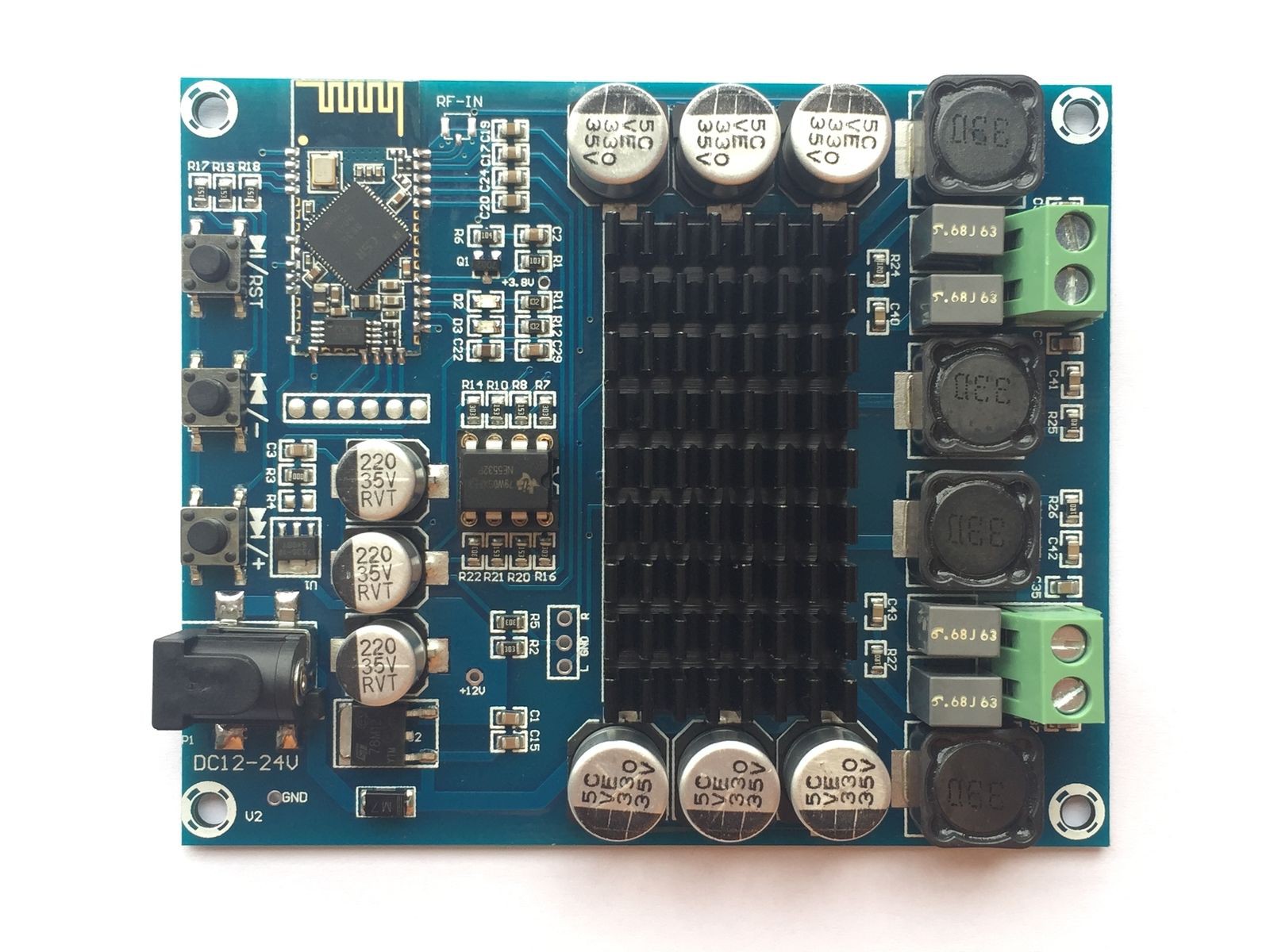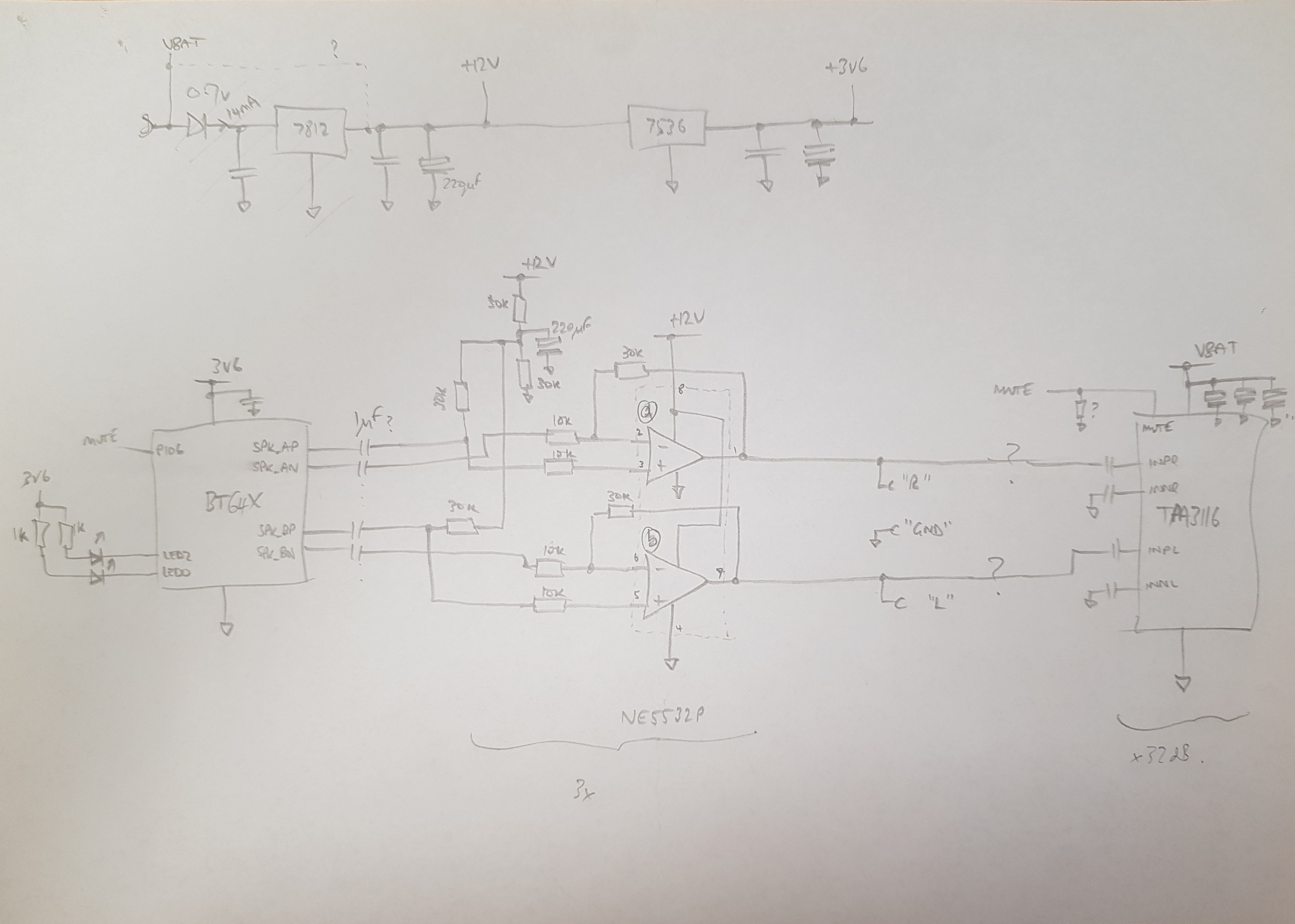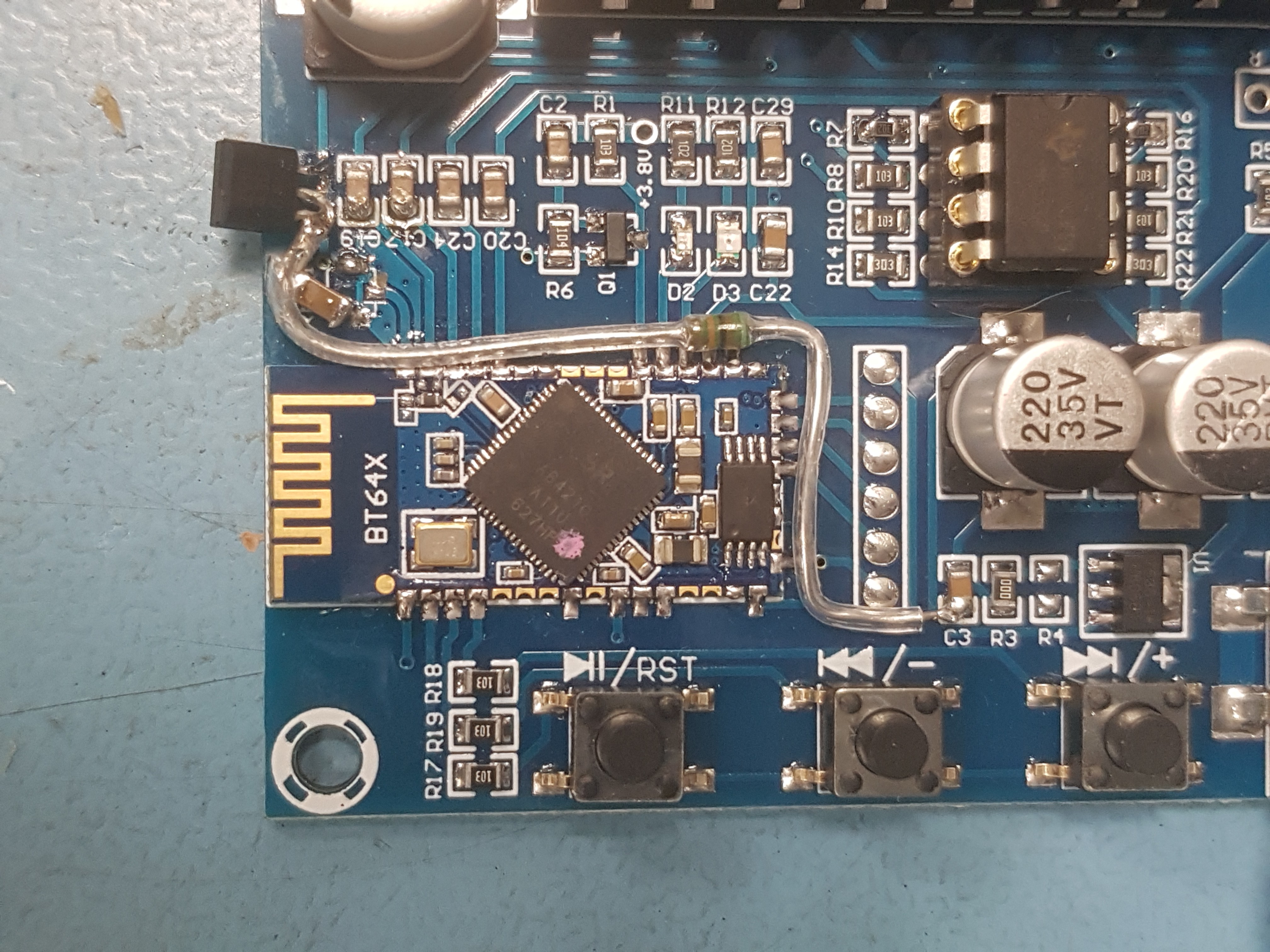
Out of the box, the amplifier module has some minor flaws:
- there's no volume control (except from the device streaming the audio)
- it's a bit noisy at low volume levels (background hiss)
- there's a 12V linear reg and reverse-polarity protection diode on the board which do almost nothing AFAIK except waste power and voltage headroom
- the audio response is (probably) flat across the band and I'll be wanting some bass boost
So this log covers the mods I make to fix these problems.
First off, quiescent power consumption. Baseline: 14mA (after BT pairing) from 15V supply => 210mW. It looks like the 12V reg is only there to power the op-amp stage and the 3V6 reg which feeds the BT module. The TPA3116 seems to be connected directly to the main supply (via the diode), so it's not as bad as I thought. Still, the NE5532 op-amp will happily run from 22V (way more than I intend to use) so we might as well skip out the diode (saving 10mW) and 12V reg (11.5mA x voltage drop, in this case 3V so 35mW).
The BT module ("BT64X", datasheet here) claims 2.8-4.2V operation but doesn't specify current. However, when it's not actually streaming, the current is very low (per CSRA64215 chipset datasheet). The bulk of the rest of the 11.5mA I measured must be the NE5532 - spec'ced at 8-16mA no load.
Not really much scope for further power savings, except running the BT module directly from first LiPo cell and doing away with the 3V6 regulator.

10/6: Did some measurements today. The op amp stage combined with the gain in the 3116 is way too much, easily clipping the output long before the volume on my phone is anywhere near maximum. In fact about 10x too much. One solution is to change the opamp stage to 0.3x (from 3x). This should reduce the hiss and the very loud bing bong tones from the BT module on startup. Or get rid of the opamp altogether and save power?... Oh, and yes the response is essentially flat down to the roll-off below 50Hz due to the series caps (at the BT module o/p and at the 3116 input).
11/6: Bypassed the diode and 12V regulator. Changed op-amp gain from 3x to 0.3x - gain looking a lot better now, music at 'normal' levels only just clips at full volume when running from 3S LiPo (11.1V) supply. Quiescent current: 11mA paired but not playing, 49mA playing music at (almost) zero volume level. Will plug speakers in later and see if the hiss is better, and if it's still loud enough! (update: yes, it is just about. Hiss is almost acceptable for bed-side use, and fine for general use)
12/6: Had a quick look at noise levels. I get ~15mVrms across the load when music is playing but at zero volume, i.e. just noise. If I short across the BT module outputs, this value does not change, meaning the noise is not originating at the BT module. If I remove the NE5532 and short an output to GND, the noise in that channel drops to ~10mVrms, suggesting that some comes from the op-amp and upstream of it. The remainder (i.e. the majority) either comes from the 3116 itself (which I doubt very much) or poor layout of the board causing pickup of switching currents. There's not much I can do about that, short of carving up ground planes, so I might just leave it. Had the designers simply routed the BT module diff outputs directly to the 3116 diff inputs, it would probably have been a whole lot better! Changing to single-ended was unnecessary (no gain required) and made things more difficult...
13/6: A number of people who've reviewed this particular 3116 board have complained about the connection tones at startup. Mainly the high volume - due to having too much gain in the op-amp stage - but also the clicks and thumps. I've just had a look with the scope and the problem is that the BT module waggles the MUTE line up and down quite a lot during the production of the tones, so it's not surprising that there are some clicks. There's also not a lot I can do (short of reprogramming the firmware in the BT module), but I might try adding a turn-on delay circuit to the MUTE line so it's ignored for the first 1-2 seconds after power-on.


The little circuit above, consisting of a MOSFET, capacitor and resistor seems to work nicely, with just one cut in the nMUTE track. The C charges from the 3V6 supply via the R and, after a few seconds, exceeds the turn-on voltage of the MOSFET (about 2.6V). Thereafter, the MOSFET is 'on' and the nMUTE signal from the BT module can pass through to the TPA3116. There are now no longer any annoying startup tones! Happy days.
12/7: Over the last week or so I've re-wired the op-amp stage of the amplifier board. Instead of being two, flat-response (stereo) channels, I've mixed left and right into the input of one of the op-amps and its output drives one channel of the TPA3116 and also the input of the other op-amp. The other op-amp has a 1st order low-pass response, with adjustable gain, and drives the other input of the TPA3116. Hence I now have a mid-top mono channel, and a sub/bass mono channel. I'll try and draw up a schematic and post it soon. Anyway, that's what's driving the speakers currently, and it sounds great!
16/7: Schematic:

23/7: Post-camping update: the speaker was great! It sounded surprisingly good outdoors, was plenty loud enough (running from a battery at ~12.0V) and got loads of compliments. I still think it has a smidge too much bass, but maybe I'll leave it for now. I'd better get on and build the finished enclosure...
Discussions
Become a Hackaday.io Member
Create an account to leave a comment. Already have an account? Log In.
Hi, and thanks. Your project sounds fun too - maybe you can link to it here so I can follow it? Lmk if I might be able to help. 7.1 sounds like a lot of amplifiers! Good luck.
Are you sure? yes | no
Nice project. I found it fishing for the schematic +/- of one of the BT amplifier boards. I want to make a 7.1 channel amp. I looked at class D amps based on the TDA7492P. Oddly enough the amp only boards are more expensive than the BT amp boards. Oh those silly Chinese. The boards I have on order are not of the ilk that have the aux input jacks. Just as well though as I am looking forward to having the BT modules to play with on another project. I figure I can extract the modules and drive the amps directly. I am envisioning trimmers for each channel to set relative levels and some kind of micro and digital pots to change the overall volume. It should be an adventure...
Are you sure? yes | no